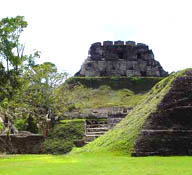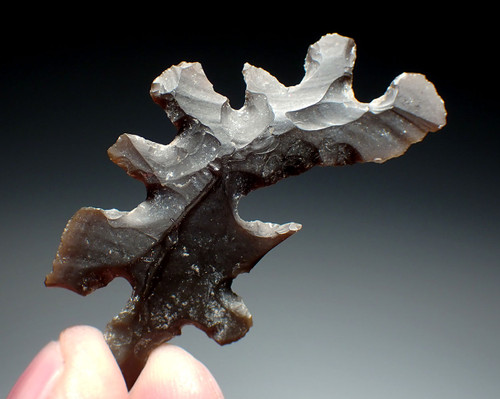Product Description
SEE MORE PRE-COLUMBIAN ARTIFACTS
Exquisitely made out of a near paper-thin flake of black obsidian, this incredible large disk applique pendant features two unbroken piercings to attach this applique to clothing, or wear as a pendant. The workmanship on the edge shows the highest form of flaking with super fine knapping performed to achieve a remarkable symmetrical round shape. This would have been an object of luxury and wealth / class display to an elite member of the ancient Pre-Columbian Mayan empire. Only the most skilled obsidian worker would have been able to craft such a complicated art object in obsidian, meaning it's ownership would have been reserved to those that could have afforded its purchase and been eligible to wear such an object. The presence of both unbroken drilled holes on each side is a further rarity.
As irrefutable evidence of this object's authenticity and completely unaltered, original state, the entire surface features original sediment and minerals impacted deep in all the flake scars and micro-crevices of the obsidian, as well as no modern crushing on any surfaces.
Obsidian is a naturally formed volcanic glass that was an important part of the material culture of Pre-Columbian Mesoamerica. Obsidian was a highly integrated part of daily and ritual life, and its widespread and varied use. Obsidian was worked into a variety of tool forms, including knives, lance and projectile points, prismatic blades, general bifacial tools, and utilized flakes. When flaked, leaves an edge that is only one molecule thick, making for the sharpest possible objects on Earth. Objects made of obsidian were used as associated grave goods, employed in sacrifice, and in art. Some non-utilitarian forms include miniature human effigies, ear spools and labrets with gold and turquoise workings, carved animal figurines, beads, vases, and as pieces of masks.
Obsidian was frequently used in ritualized autosacrifice (blood-letting) activities, ritual weapons, and weapons of warfare. Obsidian was seen as a type of blood originating from the earth – its use is therefore especially symbolic. Typically, the material's visual depiction in artwork is generally associated with autosacrifice and other types of sacrifice, including images of prismatic blades with bloody hearts on the blade's ends.
During the Preclassic period, obsidian was a rare item in the lowland areas, found predominantly in high-status and ritual contexts. In many Maya excavations evidence of obsidian is likewise found most frequently in privileged settings. As the Late Classic period progressed, obsidian became increasingly accessible to the lower classes of Maya civilization. Nevertheless, the Maya upper classes continued to remain in possession of the more prestigious Teotihuacan green obsidian.
HISTORY
 Of all the ancient cultures of the Americas, no civilization has held more intrigue and secrets for so long as that of the Mayans. In 1960, their language code of glyphs was finally deciphered and forever changed our view of what we initially thought was a peaceful and harmonious society. On the contrary, the Mayan Culture of the latter years was bathed in the blood of vicious warfare and astounding levels of human sacrifice. Their technology was so advanced it is no wonder many believe they received intelligence from extra-terrestrials. Despite our recent discoveries of Mayan mathematics, astronomy and calendar technology, the Mayans still leave us with many mysteries. Their love of war caused them to manufacture spectacular weapons with inherent beauty and artistry. Their ceramics depict a fascinating culture of status, sacrifice and deep religious devotion to a number of strange gods.
Of all the ancient cultures of the Americas, no civilization has held more intrigue and secrets for so long as that of the Mayans. In 1960, their language code of glyphs was finally deciphered and forever changed our view of what we initially thought was a peaceful and harmonious society. On the contrary, the Mayan Culture of the latter years was bathed in the blood of vicious warfare and astounding levels of human sacrifice. Their technology was so advanced it is no wonder many believe they received intelligence from extra-terrestrials. Despite our recent discoveries of Mayan mathematics, astronomy and calendar technology, the Mayans still leave us with many mysteries. Their love of war caused them to manufacture spectacular weapons with inherent beauty and artistry. Their ceramics depict a fascinating culture of status, sacrifice and deep religious devotion to a number of strange gods.
Archaeologists divide the Mayan Culture into different periods - PRE-CLASSIC (2000 BC - 250 AD), CLASSIC (250 AD - 900 AD), POST CLASSIC (950 AD - 1539 AD). The earliest days of the Maya date back to 2000 BC when small farming villages first appeared in the highlands and Pacific coastline of Guatemala. Crops such as corn, squash and beans made up the staple of their diet and are believed to have been brought from previous migration through Mexico. The Maya pottery styles were unique to the early Maya settlements, though. By 1000 BC, villages sprang up in the lowland regions. The Maya lived in the same locations for centuries and in a continuous state of architectural improvement and expansion leading up to the magnificent 'super-cities' we associate with them today. By 300 AD. full-scale cities were being built with stone featuring massive plazas, temples and pyramids reaching 20 stories high.
It is no wonder that some believe that extra-terrestrial beings brought their knowledge to the Maya. By 300 AD, the first inscriptions suddenly appeared in Maya sites. These early inscriptions were so beautiful it was as if the gods had delivered it to the Mayan themselves! Forward to 600 years later and the inscriptions cease. The first comprehensive writing system in Pre-Columbian America was invented by the Maya. Among the mysteries of the Maya are their amazing understanding of astronomy along with the development of an accurate calendar and mathematical system. Their number system was based on units of 20 and included a concept of 'zero'.
The skills of the Mayan craft are exemplified in their stone and wood carvings, flaked stone objects, pottery and personal adornment. Much of their art centers around their devotion to a religion that is both fascinating and gory. Blood-letting rituals were the norm and many acts of war were motivated by the capture of vast numbers of their enemies for ritual human sacrifice that would run for days on end, forming lakes of blood and fat at the bases of their stone pyramids that defy architectural explanation.
Our understanding of the fascinating MAYAN CULTURE was completely wrong and misinterpreted until as recent as the 1960, when major achievements were made in the deciphering of their glyph language. Elaborately designed ceremonial cities lacking any obvious defenses initially led us to believe that the Mayans were a peaceful theocracy living in ideal harmony with their environment and each other. We could not have been further from the truth. Lowland city-states lived in constant warfare with one another and the thirst of their gods for human blood and sacrifice seemed impossible to satiate.
Perhaps a lesson for us today, recent scientific analysis of the demise of the highly advanced Mayan civilization now answers the biggest mystery of all - "What ever happened to the ancient Mayans?". Long-term high population density (500 people per square mile - the highest in the world at the time) of unbelievable proportions put a strain on their agricultural system that was impossible to sustain. The effects of nutritional deficiencies are evident in bone and tooth analysis on graves dating to the Late Classic Period. It is most probable that starvation put unbearable sociopolitical stress on the society to either kill each other for food or die of hunger necessitated by the technological advancement of warfare and its escalation.
References:
- Fiedel, Stuart J., Prehistory of the Americas, 1992 - Freeman and Company, Early Man in America, 1973
- Hirth Kenneth, Obsidian Craft Production in Ancient Central Mexico, 2006
- Muser, Curt, Facts and Artifacts of Ancient Middle America, 1978
- Phillips, Charles, The Complete Illustrated History of the Aztec and Maya, 2008
 US DOLLAR
US DOLLAR
 EURO
EURO
 AUSTRALIAN DOLLAR
AUSTRALIAN DOLLAR
 CANADIAN DOLLAR
CANADIAN DOLLAR
 POUND STERLING
POUND STERLING






















